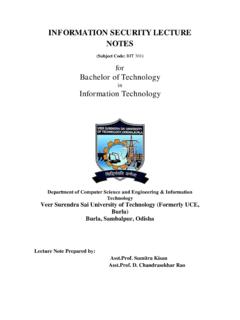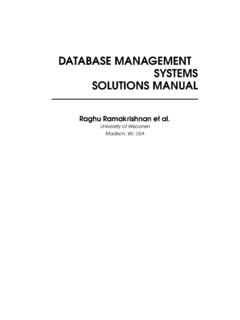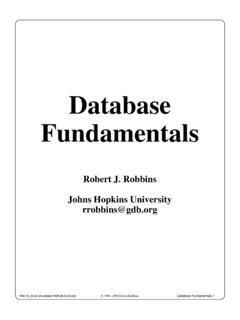Transcription of Data Mining: Concepts and Techniques - Veer Surendra Sai ...
1 Data Mining: Concepts and Techniques Chapter I: Introduction to Data Mining We are in an age often referred to as the information age. In this information age, because we believe that information leads to power and success, and thanks to sophisticated technologies such as computers, satellites, etc., we have been collecting tremendous amounts of information. Initially, with the advent of computers and means for mass digital storage, we started collecting and storing all sorts of data, counting on the power of computers to help sort through this amalgam of information. Unfortunately, these massive collections of data stored on disparate structures very rapidly became overwhelming. This initial chaos has led to the creation of structured databases and database management systems (DBMS).
2 The efficient database management systems have been very important assets for management of a large corpus of data and especially for effective and efficient retrieval of particular information from a large collection whenever needed. The proliferation of database management systems has also contributed to recent massive gathering of all sorts of information. Today, we have far more information than we can handle: from business transactions and scientific data, to satellite pictures, text reports and military intelligence. Information retrieval is simply not enough anymore for decision-making. Confronted with huge collections of data, we have now created new needs to help us make better managerial choices.
3 These needs are automatic summarization of data, extraction of the "essence" of information stored, and the discovery of patterns in raw data. Data mining is a powerful new technology with great potential to help companies focus on the most important information in their data warehouses. It has been defined as: The automated analysis of large or complex data sets in order to discover significant patterns or trends that would otherwise go unrecognised. The key elements that make data mining tools a distinct form of software are: Automated analysis Data mining automates the process of sifting through historical data in order to discover new information. This is one of the main differences between data mining and statistics, where a model is usually devised by a statistician to deal with a specific analysis problem.
4 It also distinguishes data mining from expert systems, where the model is built by a knowledge engineer from rules extracted from the experience of an expert. The emphasis on automated discovery also separates data mining from OLAP and simpler query and reporting tools, which are used to verify hypotheses formulated by the user. Data mining does not rely on a user to define a specific query, merely to formulate a goal - such as the identification of fraudulent claims. Large or complex data sets One of the attractions of data mining is that it makes it possible to analyse very large data sets in a reasonable time scale. Data mining is also suitable for complex problems involving relatively small amounts of data but where there are many fields or variables to analyse.
5 However, for small, relatively simple data analysis problems there may be simpler, cheaper and more effective solutions. Discovering significant patterns or trends that would otherwise go unrecognised The goal of data mining is to unearth relationships in data that may provide useful insights. Data mining tools can sweep through databases and identify previously hidden patterns in one step. An example of pattern discovery is the analysis of retail sales data to identify seemingly unrelated products that are often purchased together. Other pattern discovery problems include detecting fraudulent credit card transactions, performance bottlenecks in a network system and identifying anomalous data that could represent data entry keying errors. The ultimate significance of these patterns will be assessed by a domain expert - a marketing manager or network supervisor - so the results must be presented in a way that human experts can understand.
6 Data mining tools can also automate the process of finding predictive information in large databases. Questions that traditionally required extensive hands-on analysis can now be answered directly from the data quickly. A typical example of a predictive problem is targeted marketing. Data mining uses data on past promotional mailings to identify the targets most likely to maximize return on investment in future mailings. Other predictive problems include forecasting bankruptcy and other forms of default, and identifying segments of a population likely to respond similarly to given events. Data mining Techniques can yield the benefits of automation on existing software and hardware platforms to enhance the value of existing information resources, and can be implemented on new products and systems as they are brought on-line.
7 When implemented on high performance client/server or parallel processing systems, they can analyse massive databases to deliver answers to questions such as: "Which clients are most likely to respond to my next promotional mailing, and why?" Data mining is ready for application because it is supported by three technologies that are now sufficiently mature: Massive data collection Powerful multiprocessor computers Data mining algorithms Commercial databases are growing at unprecedented rates, especially in the retail sector. The accompanying need for improved computational engines can now be met in a cost-effective manner with parallel multiprocessor computer technology. Data mining algorithms embody Techniques that have existed for at least 10 years, but have only recently been implemented as mature, reliable, understandable tools that consistently outperform older statistical methods.
8 The core components of data mining technology have been under development for decades, in research areas such as statistics, artificial intelligence, and machine learning. Today, the maturity of these Techniques , coupled with high-performance relational database engines and broad data integration efforts, make these technologies practical for current data warehouse environments. The key to understanding the different facets of data mining is to distinguish between data mining applications, operations, Techniques and algorithms. Applications database marketing customer segmentation customer retention fraud detection credit checking web site analysis Operations Classification and prediction clustering association analysis forecasting Techniques Neural networks decision trees K-nearest neighbour algorithms naive Bayesian cluster analysis What kind of information are we collecting?
9 We have been collecting a myriad of data, from simple numerical measurements and text documents, to more complex information such as spatial data, multimedia channels, and hypertext documents. Here is a non-exclusive list of a variety of information collected in digital form in databases and in flat files. Business transactions: Every transaction in the business industry is (often) "memorized" for transactions are usually time related and can be inter-business deals such as purchases, exchanges, banking, stock, etc., or intra-business operations such as management of in-house wares and assets. Large department stores, for example, thanks to the widespread use of bar codes, store millions of transactions daily representing often terabytes of data.
10 Storage space is not the major problem, as the price of hard disks is continuously dropping, but the effective use of the data in a reasonable time frame for competitive decision-making is definitely the most important problem to solve for businesses that struggle to survive in a highly competitive world. Scientific data: Whether in a Swiss nuclear accelerator laboratory counting particles, in the Canadian forest studying readings from a grizzly bear radio collar, on a South Pole iceberg gathering data about oceanic activity, or in an American university investigating human psychology, our society is amassing colossal amounts of scientific data that need to be analyzed. Unfortunately, we can capture and store more new data faster than we can analyze the old data already accumulated.














